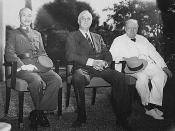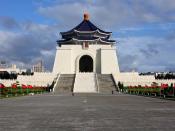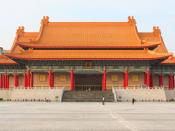In 1949, the Nationalist party of China, the Guomindang, fled from mainland China after a civil war with the Chinese Communist Party. The KMT's failure was due to poor management and widespread corruption within the party.
In 1912, the last Chinese Emperor resigned, with many parts of China resisting Imperial rule. Because of this, China disintegrated into various smaller provinces, each one rules by a different warlord. Around this time, two political parties were formed. One was a Nationalist Party, the KMT, founded by Sun Yat-sen. The other was a Communist party, the CCP. From 1925, to 1927, the CCP and the KMT were united in efforts to unify China, and defeat the warlords. However in 1927 Chiang Kai-shek, the KMT leader, decided that the Communists were a threat to National unity. He ordered members of the Guomindang to turn their guns on the Communists. 5 600 Communists were killed in the massacre, though many fled into neighboring mountains.
In 1928, the KMT was far more powerful than the CCP. The CCP was constantly besieged by Nationalist forces. In 1934, the CCP's army fled from its Southern stronghold to its Northern Province. They were relentlessly harried by KMT forces, and it took a year to march the long distance. The Long March gave the CCP the opportunity to spread the ideals of Communism to ordinary Chinese people. This made the people believe that Communism would be better for them than any of the ideals of the KMT. Even while Japan sat on China's northern borders, an army poised to invade; Chiang sent his forces to assail the CCP in the south. Chiang was determined to destroy the Communists.
In 1937, Japan invaded China and once again the CCP and the KMT were united. During the years of war with...



China Why were the communists successful in taking control of China from the Guomindang [Nationalists] by 1949?
To begin with the weaknesses, there is a good deal of redundancy. This essay reads as if the writer summarized each source in sequence, without bothering to note that the sources say largely the same thing. Rather than attempt to synthesize the source material, the writer merely went through some of the same points three times over.
The writer never bothers to make clear that the KMT is the Guomindang.
For the good points, this essay shows some reasonable good research and some solid thought.
0 out of 1 people found this comment useful.